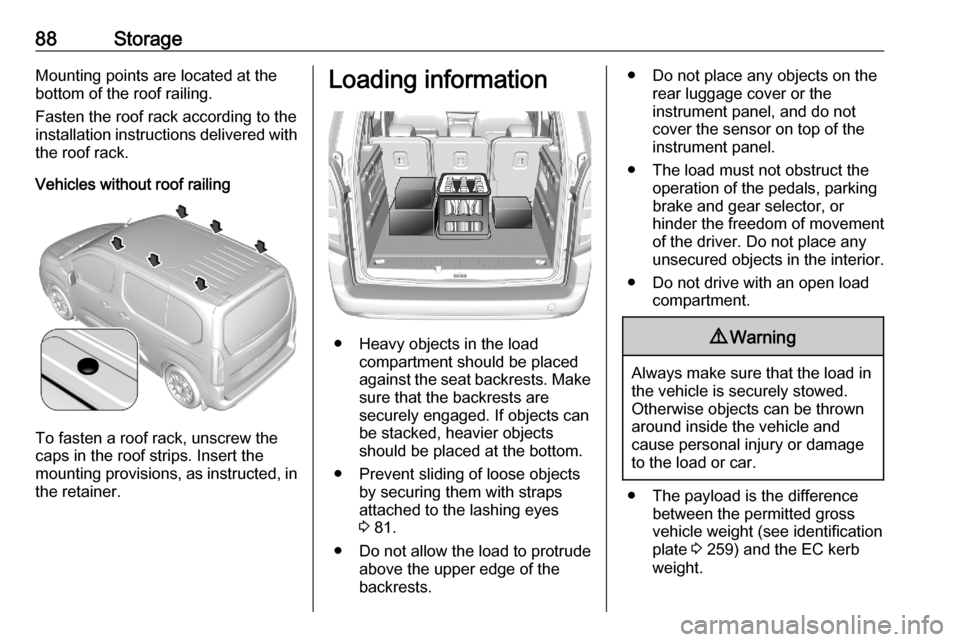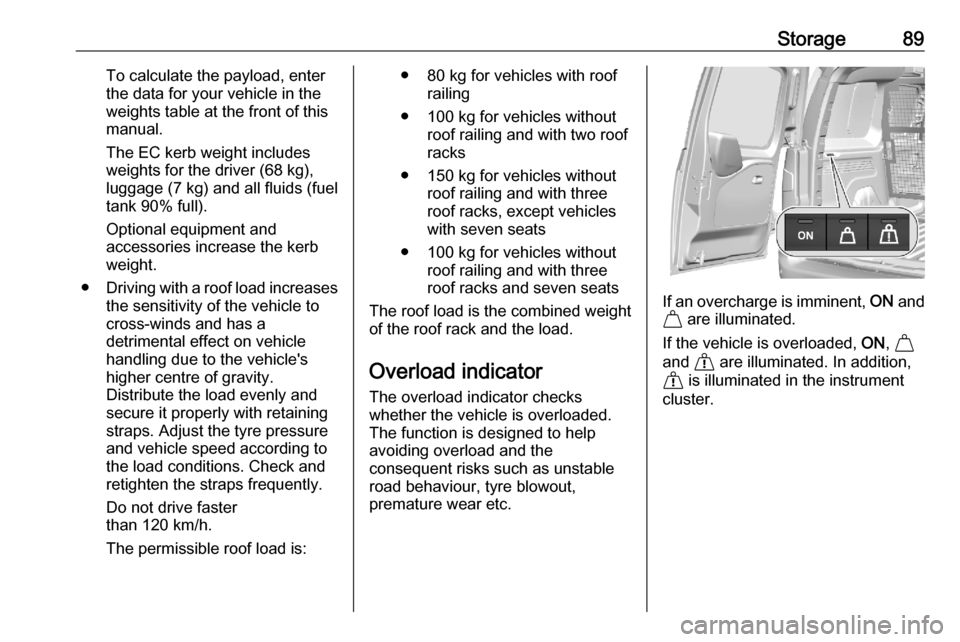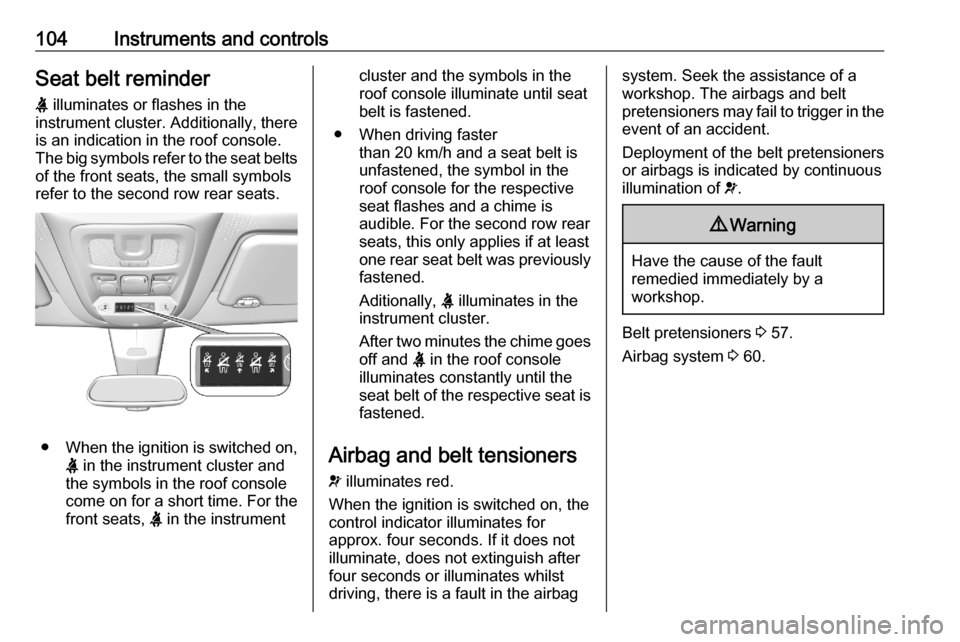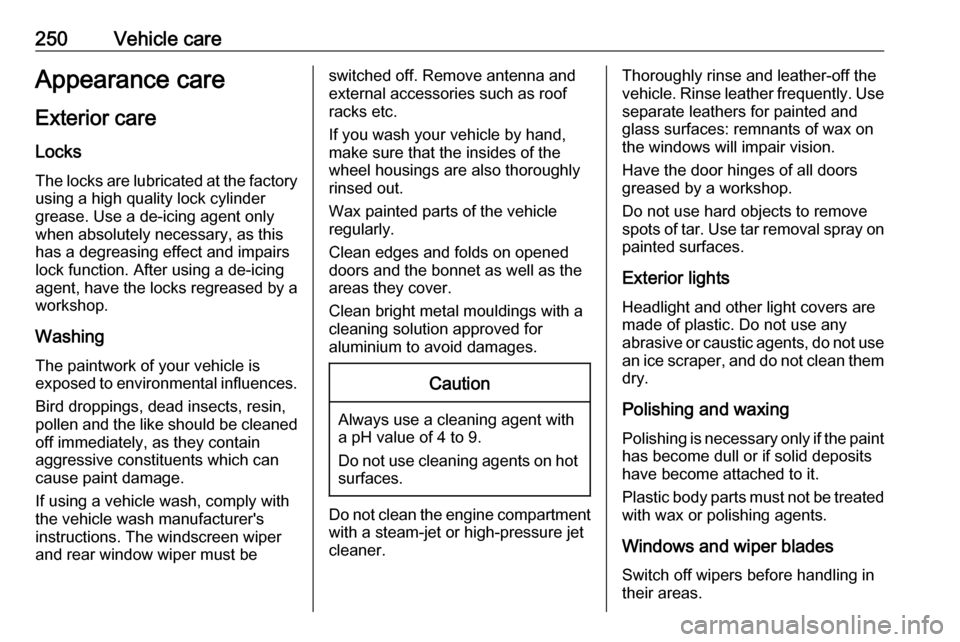roof OPEL COMBO E 2020 Manual user
[x] Cancel search | Manufacturer: OPEL, Model Year: 2020, Model line: COMBO E, Model: OPEL COMBO E 2020Pages: 283, PDF Size: 29.4 MB
Page 90 of 283

88StorageMounting points are located at the
bottom of the roof railing.
Fasten the roof rack according to the
installation instructions delivered with
the roof rack.
Vehicles without roof railing
To fasten a roof rack, unscrew the
caps in the roof strips. Insert the
mounting provisions, as instructed, in the retainer.
Loading information
● Heavy objects in the load compartment should be placed
against the seat backrests. Make
sure that the backrests are
securely engaged. If objects can
be stacked, heavier objects
should be placed at the bottom.
● Prevent sliding of loose objects by securing them with straps
attached to the lashing eyes
3 81.
● Do not allow the load to protrude above the upper edge of the
backrests.
● Do not place any objects on the rear luggage cover or the
instrument panel, and do not cover the sensor on top of theinstrument panel.
● The load must not obstruct the operation of the pedals, parking
brake and gear selector, or
hinder the freedom of movement
of the driver. Do not place any
unsecured objects in the interior.
● Do not drive with an open load compartment.9Warning
Always make sure that the load in
the vehicle is securely stowed.
Otherwise objects can be thrown
around inside the vehicle and
cause personal injury or damage
to the load or car.
● The payload is the difference between the permitted gross
vehicle weight (see identification
plate 3 259) and the EC kerb
weight.
Page 91 of 283

Storage89To calculate the payload, enter
the data for your vehicle in the
weights table at the front of this
manual.
The EC kerb weight includes
weights for the driver (68 kg),
luggage (7 kg) and all fluids (fuel
tank 90% full).
Optional equipment and
accessories increase the kerb
weight.
● Driving with a roof load increases
the sensitivity of the vehicle to
cross-winds and has a
detrimental effect on vehicle
handling due to the vehicle's
higher centre of gravity.
Distribute the load evenly and secure it properly with retaining
straps. Adjust the tyre pressure
and vehicle speed according to
the load conditions. Check and
retighten the straps frequently.
Do not drive faster
than 120 km/h.
The permissible roof load is:● 80 kg for vehicles with roof railing
● 100 kg for vehicles without roof railing and with two roofracks
● 150 kg for vehicles without roof railing and with three
roof racks, except vehicles
with seven seats
● 100 kg for vehicles without roof railing and with three
roof racks and seven seats
The roof load is the combined weight
of the roof rack and the load.
Overload indicator
The overload indicator checks
whether the vehicle is overloaded.
The function is designed to help
avoiding overload and the
consequent risks such as unstable
road behaviour, tyre blowout,
premature wear etc.
If an overcharge is imminent, ON and
% are illuminated.
If the vehicle is overloaded, ON, %
and & are illuminated. In addition,
& is illuminated in the instrument
cluster.
Page 106 of 283

104Instruments and controlsSeat belt reminderX illuminates or flashes in the
instrument cluster. Additionally, there is an indication in the roof console.
The big symbols refer to the seat belts of the front seats, the small symbols
refer to the second row rear seats.
● When the ignition is switched on,
X in the instrument cluster and
the symbols in the roof console
come on for a short time. For the
front seats, X in the instrument
cluster and the symbols in the
roof console illuminate until seat
belt is fastened.
● When driving faster than 20 km/h and a seat belt is
unfastened, the symbol in the
roof console for the respective
seat flashes and a chime is
audible. For the second row rear
seats, this only applies if at least
one rear seat belt was previously
fastened.
Aditionally, X illuminates in the
instrument cluster.
After two minutes the chime goes off and X in the roof console
illuminates constantly until the seat belt of the respective seat is
fastened.
Airbag and belt tensioners v illuminates red.
When the ignition is switched on, the control indicator illuminates for
approx. four seconds. If it does not illuminate, does not extinguish after
four seconds or illuminates whilst
driving, there is a fault in the airbagsystem. Seek the assistance of a
workshop. The airbags and belt
pretensioners may fail to trigger in the event of an accident.
Deployment of the belt pretensioners
or airbags is indicated by continuous
illumination of v.9 Warning
Have the cause of the fault
remedied immediately by a
workshop.
Belt pretensioners 3 57.
Airbag system 3 60.
Page 186 of 283

184Driving and operatingEmergency automatic braking may
slow the vehicle to a complete stop to
try to avoid a potential crash.
● Automatic transmission: If the vehicle comes to a completestop, automatic braking is
maintained for up to two
seconds. Keep the brake pedal
depressed to prevent the vehicle
from starting off again.
● Manual transmission: If the vehicle comes to a complete
stop, the engine may stall.
Operation of the function may be felt
by a slight vibration in the brake
pedal.9 Warning
Emergency automatic braking is
an emergency crash preparation
feature and is not designed to
avoid crashes. Do not rely on the
system to brake the vehicle.
Emergency automatic braking will
not brake outside of its operating speed range and only responds to
detected vehicles and
pedestrians.
System limitations
In some cases, the active emergencybraking system may provide an
automatic braking in situations that
seem to be unnecessary, for instance
in parking garages, due to traffic signs
in a curve or due to vehicles in
another lane. This is normal
operation, the vehicle does not need
service. Firmly apply the accelerator
pedal to override the automatic
braking if the situation and the
surroundings permit.
In the following cases, active
emergency braking performance is
limited:
● driving on winding or hilly roads
● detecting all vehicles, especially vehicles with a trailer, tractors,
muddy vehicles, etc.
● detecting a vehicle when weather
limits visibility, such as in fog,
rain, or snow
● driving during nighttime
● windscreen damaged or stickeredComplete attention is always requiredwhile driving, and you should be
ready to take action and apply the
brakes and / or steer the vehicle to
avoid crashes.
We recommend to deactivate the
system in the vehicle personalisation
in the following cases:
● when towing a trailer or caravan
● when carrying long objects on roof bars or a roof rack
● when the vehicle is being towed with the engine running
● when a spare wheel is fitted that is smaller than the other wheels
● before using an automatic car wash with the engine running
● before placing the vehicle on a rolling road in a workshop
● if the windscreen has been damaged close to the camera
● if the front bumper has been damaged
● if the brake lights are not working
Page 252 of 283

250Vehicle careAppearance careExterior care
Locks The locks are lubricated at the factoryusing a high quality lock cylinder
grease. Use a de-icing agent only
when absolutely necessary, as this
has a degreasing effect and impairs
lock function. After using a de-icing
agent, have the locks regreased by a
workshop.
WashingThe paintwork of your vehicle is
exposed to environmental influences.
Bird droppings, dead insects, resin,
pollen and the like should be cleaned
off immediately, as they contain
aggressive constituents which can cause paint damage.
If using a vehicle wash, comply with
the vehicle wash manufacturer's
instructions. The windscreen wiperand rear window wiper must beswitched off. Remove antenna and
external accessories such as roof
racks etc.
If you wash your vehicle by hand,
make sure that the insides of the
wheel housings are also thoroughly
rinsed out.
Wax painted parts of the vehicle
regularly.
Clean edges and folds on opened
doors and the bonnet as well as the
areas they cover.
Clean bright metal mouldings with a
cleaning solution approved for
aluminium to avoid damages.Caution
Always use a cleaning agent with
a pH value of 4 to 9.
Do not use cleaning agents on hot surfaces.
Do not clean the engine compartment
with a steam-jet or high-pressure jet
cleaner.
Thoroughly rinse and leather-off the vehicle. Rinse leather frequently. Use
separate leathers for painted and
glass surfaces: remnants of wax on
the windows will impair vision.
Have the door hinges of all doors
greased by a workshop.
Do not use hard objects to remove
spots of tar. Use tar removal spray on
painted surfaces.
Exterior lights
Headlight and other light covers are
made of plastic. Do not use any
abrasive or caustic agents, do not use an ice scraper, and do not clean them
dry.
Polishing and waxing
Polishing is necessary only if the paint
has become dull or if solid deposits
have become attached to it.
Plastic body parts must not be treated with wax or polishing agents.
Windows and wiper blades Switch off wipers before handling in
their areas.
Page 258 of 283

256Service and maintenance
Engine code
EB2ADT
EB2ADTS
DV5RC
DV5RD
DV5RE
DV6FE
DV6FD
DV6D
Country group 415,000 km / 1 year15,000 km / 1 year15,000 km / 1 year15,000 km / 1 yearCountry group 510,000 km / 1 year10,000 km / 1 year10,000 km / 1 year10,000 km / 1 year1) Unless otherwise indicated in the service display.Country Group 1:
Andorra, Austria, Belgium,Cyprus, Denmark, Finland, France, Germany, Greece, Iceland, Ireland, Italy, Liechtenstein, Luxembourg, Malta, Monaco, Netherlands, Norway, Portugal, San Marino, Spain, Sweden, Switzerland, United Kingdom.Country Group 2:
Bosnia-Herzegovina, Bulgaria, Croatia, Czech Republic, Estonia, Hungary, Latvia, Lithuania, North Macedonia, Poland,
Romania, Slovakia, Slovenia.Country Group 3:
Albania, Montenegro, Serbia.Country Group 4:
Israel, South Africa, Turkey.Country Group 5:
All other countries which are not listed in the previous country groups.Confirmations
Confirmation of service is recorded in the Service and warranty booklet. The date and mileage is completed with the stamp
and signature of the servicing workshop.
Make sure that the Service and warranty booklet is completed correctly as continuous proof of service is essential if any warranty or goodwill claims are to be met, and is also a benefit when selling the vehicle.
Page 267 of 283
![OPEL COMBO E 2020 Manual user Technical data265Vehicle dimensionsSizeL1L2Length [mm]44034753Width without exterior mirrors [mm]18481848Width with exterior mirrors [mm]21072107Combo LIFE
Height without roof railing [mm]1800 - 18071 OPEL COMBO E 2020 Manual user Technical data265Vehicle dimensionsSizeL1L2Length [mm]44034753Width without exterior mirrors [mm]18481848Width with exterior mirrors [mm]21072107Combo LIFE
Height without roof railing [mm]1800 - 18071](/img/37/18815/w960_18815-266.png)
Technical data265Vehicle dimensionsSizeL1L2Length [mm]44034753Width without exterior mirrors [mm]18481848Width with exterior mirrors [mm]21072107Combo LIFE
Height without roof railing [mm]1800 - 18071812 - 1818Combo LIFE
Height with roof railing [mm]1837 - 18441843 - 1849Combo
Height without roof railing [mm]1796 - 18511815 - 1821Combo
Height with roof railing [mm]1797 - 19981845 - 1857Wheelbase [mm]27852975 / 2977Turning circle diameter [m]10.8 / 1111.5 / 11.8
Page 281 of 283

279PPanoramic view system ..............196
Parking ................................ 21, 153
Parking assist ............................ 186
Parking brake ..................... 106, 163
Parking heater ............................ 141
Parking lights ............................. 129
Particulate filter ........................... 154
Passenger side camera ..............195
Performing work ........................216
Peripheral lighting .......................132
Power button .............................. 147
Power outlets ............................... 96
Power windows ............................ 42
Preheating ................................. 108
Puncture ..................................... 242
R Radio Frequency Identification (RFID) ..................................... 274
Radio remote control ...................23
Rain sensor ................................ 110
REACH ....................................... 270
Reading lights ............................ 130
Rear doors ................................... 32
Rear fog light .............110, 128, 226
Rear view camera ...................... 199
Rear view display .................41, 116
Rear windows .............................. 44
Rear window wiper and washer ..95Recommended fluids and
lubricants ........................ 257, 261
Refuelling ................................... 207 Registered trademarks ...............270
Removing seats ............................ 54
Reversing lights .........................129
Ride control systems ..................166
Roadside assistance ..................122
Roller blinds ................................. 45
Roof .............................................. 46
Roof load ...................................... 88
Roof rack ..................................... 87
S Safety net .................................... 82
Seat adjustment ....................... 7, 49 Seat belt ........................................ 8
Seat belt reminder .....................104
Seat belts ..................................... 57
Seat folding .................................. 50
Seat heating ................................. 52
Seat position ................................ 48
Second row seats ........................53
Selective catalytic reduction .......155
Selective ride control ..................168
Selector lever.............................. 158
Service ............................... 144, 254
Service display .......................... 102
Service information ....................254
Service vehicle soon .................. 105Side airbag system ......................63
Side blind spot alert ............110, 194
Sidelights .................................... 124
Side turn lights ........................... 229
Sliding door .................................. 31
Sliding side door ........................... 31
SOS ............................................ 122
Spare wheel ............................... 242
Speed limiter....................... 110, 172
Speedometer ............................. 100
Starting and operating ................146
Starting off ................................... 19
Starting the engine ....................148
Steering ...................................... 146
Steering wheel adjustment ......9, 92
Steering wheel controls ...............92
Stop engine ................................ 105
Stop-start system........................ 150
Storage ......................................... 72
Storage compartments .................72
Sunvisor lights ........................... 130
Sun visors .................................... 45
Symbols ......................................... 4
System check ............................. 106
T
Tachometer ............................... 101
Tailgate ......................................... 33
Tail lights ................................... 226
Third row seats ............................ 54